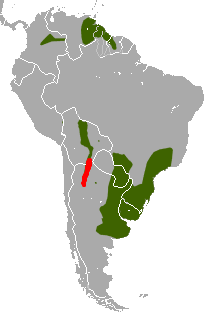Massoia's thick-tailed pouch rat
| Massoia's thick-tailed pouch rat | ||||||||||||
|---|---|---|---|---|---|---|---|---|---|---|---|---|
| Systematics | ||||||||||||
|
||||||||||||
| Scientific name | ||||||||||||
| Lutreolina massoia | ||||||||||||
| Martínez-Lanfranco , Flores , Jayat & D'Elía , 2014 |

Massoias thick-tailed pouch rat ( Lutreolina massoia ) is a species of marsupial from the family of opossum rats (Didelphidae), which occurs in the mountain forests of the Yungas in southern Bolivia (Departamentos Chuquisaca and Tarija ) and in neighboring Argentina. The species was only described in 2014 and named in honor of Elio Massoia (1936–2001), an author who wrote numerous articles on the diversity of South American mammals and who was the first to notice in 1973 that the thick-tailed pouch rats of the Yungas differed from the common thick-tailed pouch rats ( Lutreolina crassicaudata ).
description
The animals reach a head body length of 19 to 24 centimeters, a tail length of 21 to 25.5 centimeters and a weight of about 280 grams and are thus significantly smaller than their sister species, the thick-tailed pouch rat ( L. crassicaudata ). The short coat is a solid olive brown. A dark stripe on the back, contrasting dark circles or other markings are missing. The cheeks, throat, chest and stomach are cinnamon to orange in color. The legs are short and stocky. The tail is thick and as long as the body. The first third is the same color as the body. The middle of the tail is sooty black, the last third is yellowish to orange. The ears are short, round, brown in color and only slightly hairy.
Way of life
Massoia's thick-tailed pouch rat lives at heights of 400 to 2000 meters in mountain forests with dense undergrowth, in marshes and swamps, always near open water. It feeds on small mammals, fish, invertebrates, bird eggs, and fruits. Nothing is known about their reproduction so far. Massoia's thick-tailed pouch rat can climb and swim well. The animals are probably active at night or at dawn.
Danger
Massoia's thick-tailed pouch rat lives exclusively in the Yungas , a 56,000 km² mountain forest area that is becoming increasingly fragmented and is increasingly suffering from human use. However, the animals are still relatively numerous. In Argentina it occurs in the national parks of Baritú , Calilegua and El Rey as well as in some other protected areas.
Individual evidence
- ↑ a b c d Diego Astúa: Family Didelphidae (Opossums). Page 159 in Don E. Wilson , Russell A. Mittermeier : Handbook of the Mammals of the World - Volume 5. Monotremes and Marsupials. Lynx Editions, 2015, ISBN 978-84-96553-99-6
- ↑ a b c d Juan A. Martínez-Lanfranco, David Flores, J. Pablo Jayat, Guillermo D'Elía: A new species of lutrine opossum, genus Lutreolina Thomas (Didelphidae), from the South American Yungas. Journal of Mammalogy, 95 (2): 225-240. 2014. DOI: 0.1644 / 13-MAMM-A-246